The last few months have been quite tumultuous, but deep breath ... now life is starting to resume a more normal tempo, and I am once again turning my attention to telling you about what is going on - and coming up - in my music and audio life here at Jeff's Place and Positive Feedback.
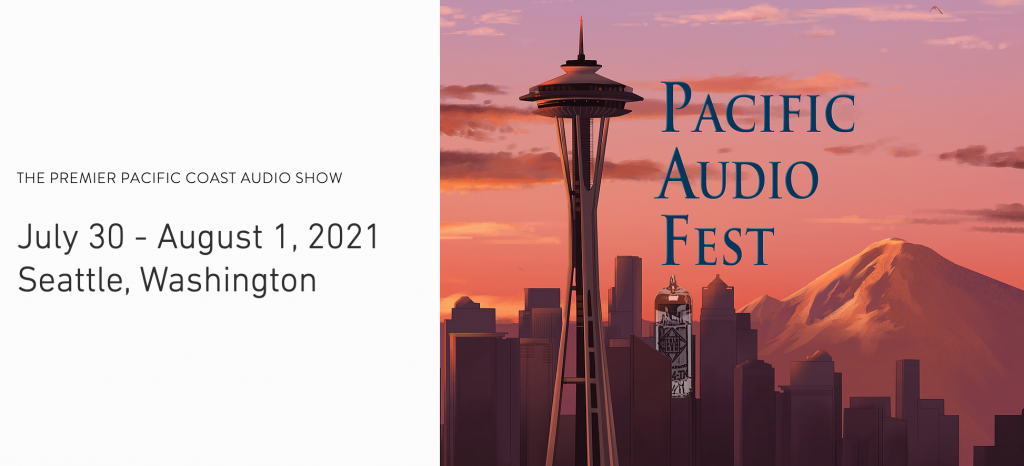
2021 is still nearly as crazy as 2020, but looks to be on a more positive trajectory already, and with a little luck the Pacific Audio Fest in Seattle will get a "green light" to proceed at the end of July, as the situation with coronavirus improves.
"Lou Hinkley of Daedalus Audio, in collaboration with Gary Gill of Capital Audiofest, are pleased to announce the launch of the Pacific Audio Fest, slated for July 30-Augst 1 2021. The Pacific Audio Fest is first and foremost a show by exhibitors for exhibitors. With that in mind, we are always open to input and will do everything possible to make this a great show and a lot of fun for exhibitors and attendees and the entire audio community."
As we get a little closer to show time I'll be interviewing Lou Hinkley about the show, and sharing that with you, and I also intend to provide in-person coverage at the show.
Sounds like fun doesn't it!
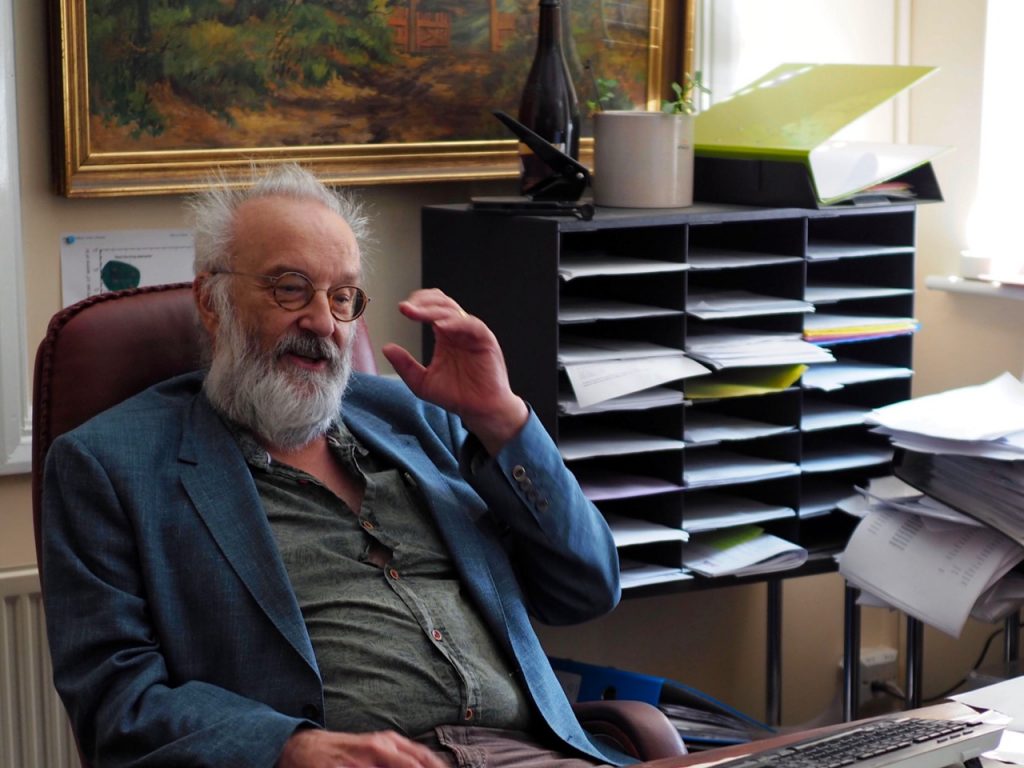
Peter Qvortrup, Audio Note (UK).
Assuming the show is able to go on, I'll have some very special coverage for you of the audio system that Peter Qvortrup of Audio Note (UK) will be displaying at the show, which will be making a stop a Jeff's Place prior to the show.
Here's the back story: A while back Peter got in touch with me and proposed a very cool idea. In advance to coming the Pacific Audio Fest, Peter proposed sending me the Audio Note (UK) system he will have at the show to set up here at Jeff's Place for a special preview for all the Jeff's Place and Positive Feedback readers.
I'll get Peter's full Audio Note (UK) system set up here at Jeff's Place, then tell you all about it prior to the show. Then you can come to the Pacific Audio Fest and experience the system for yourself.
What is even more cool, is that Peter and Daniel (Peter's son) are going to do a road trip to Jeff's Place prior to the show that I'll also be telling you about.
After Peter and Daniel's visit, we'll box up the system and transport it to Seattle for the Pacific Audio Fest.
Fingers crossed that the coronavirus is tamed by then so all can proceed as planned!
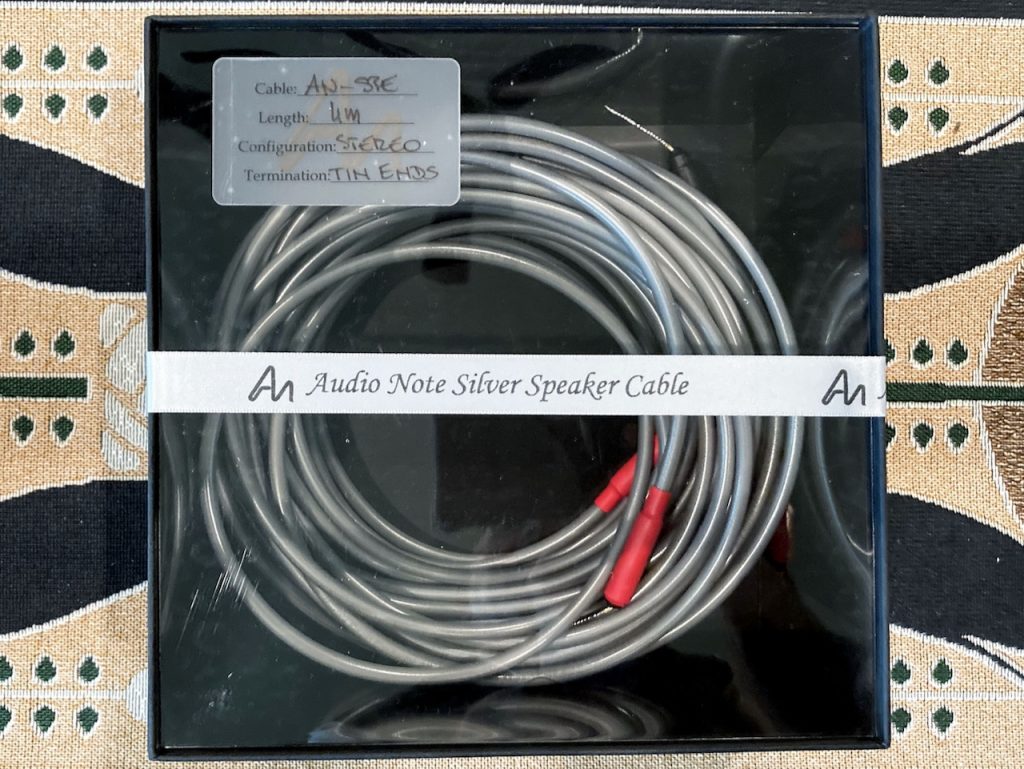
Audio Note (UK) AN-SPe silver loudspeaker cables.
You might remember that I currently have Audio Note (UK) AN-SPe silver loudspeaker cables ...
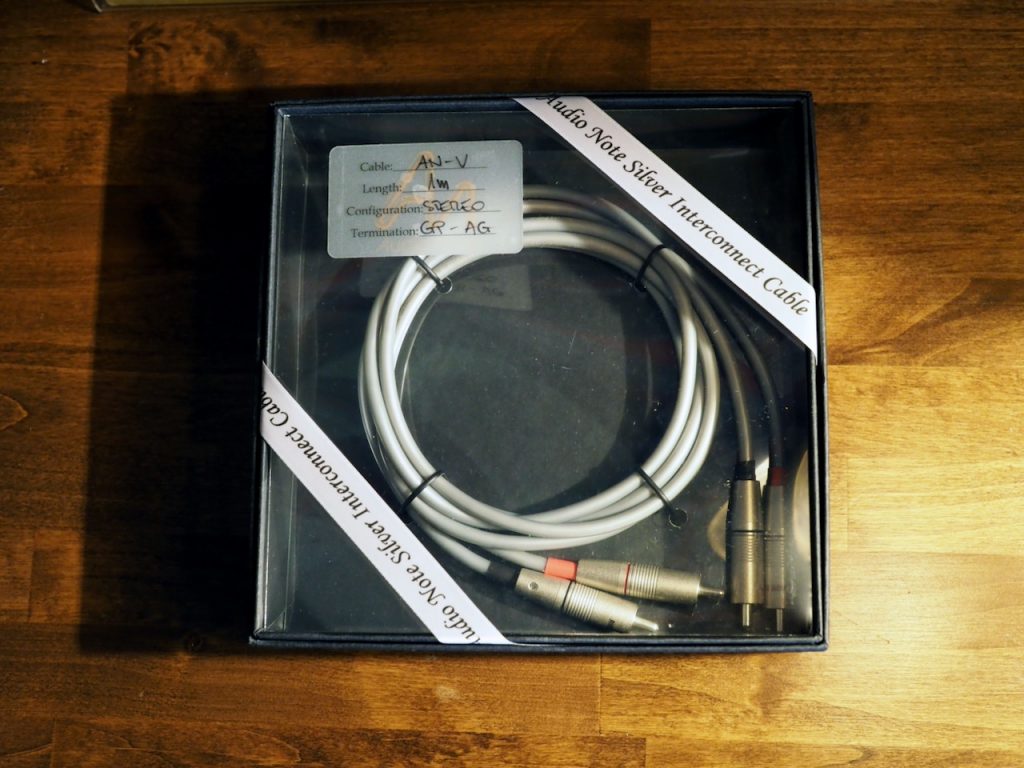
Audio Note (UK) AN-V silver interconnects.
... the Audio Note (UK) AN-V silver interconnects ...
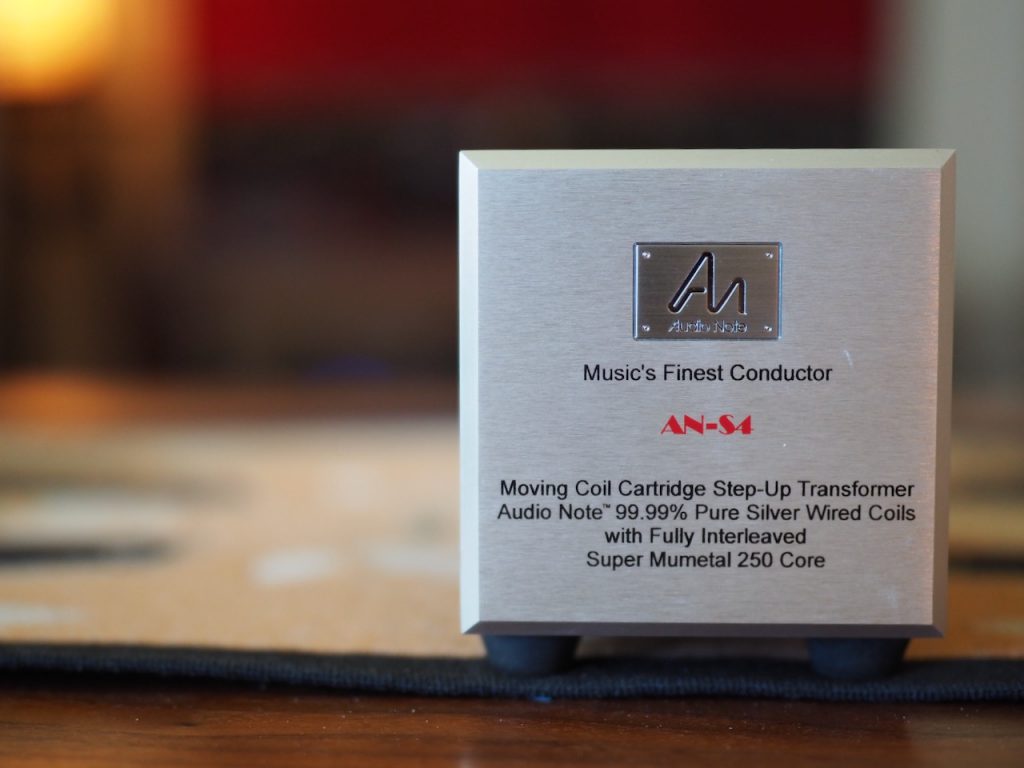
Audio Note (UK) AN-S4 step-up transformer (SUT).
... the Audio Note (UK) AN-S4 step-up transformer (SUT) ...
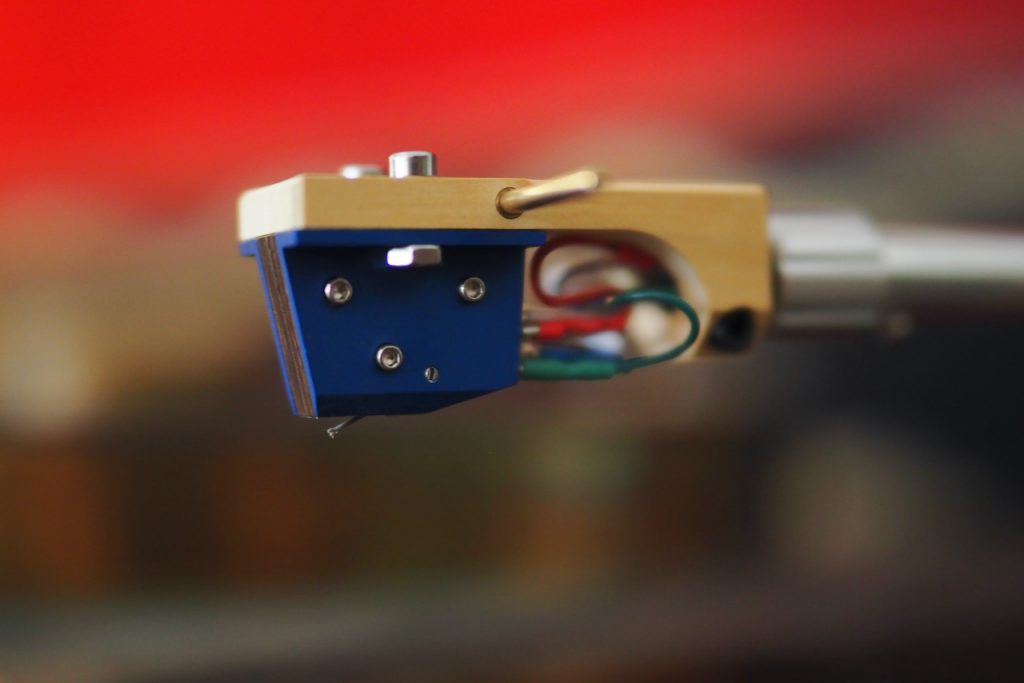
Audio Note (UK) Io I moving coil phonograph cartridge.
... and the Audio Note (UK) Io I moving coil phonograph cartridge here to tell you all about.
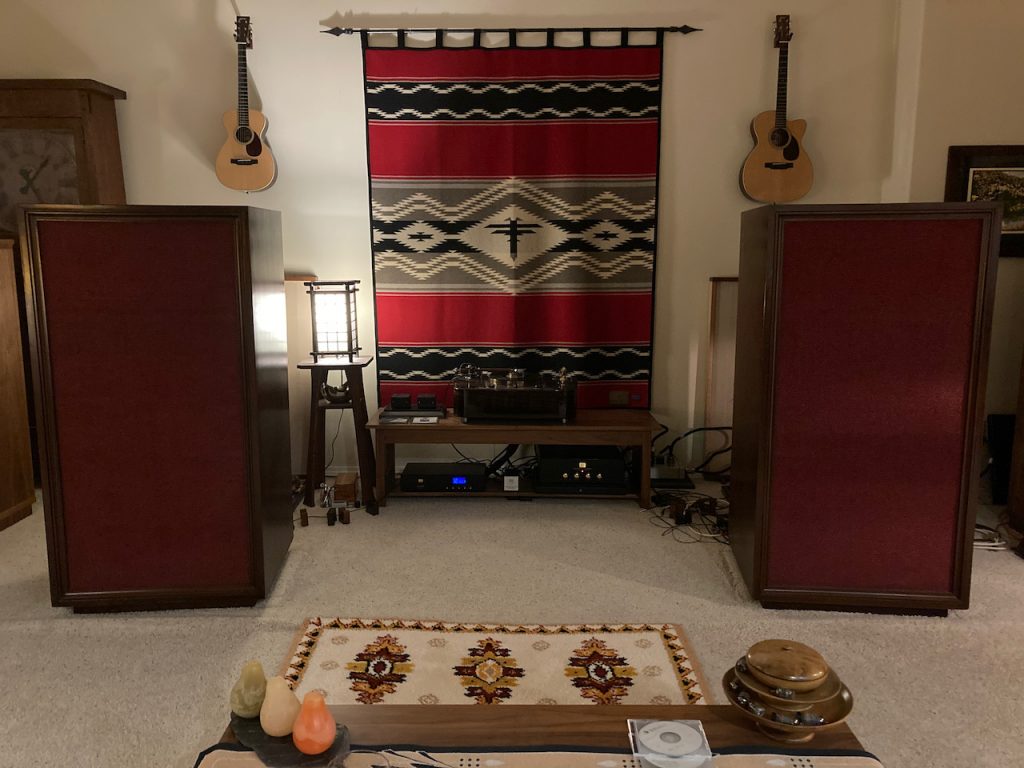
"Stokowski" Altec loudspeakers with Audio Note (UK) equipment.
I've been listening to an almost full Audio Note (UK) system providing the juice to my lovely vintage "Stokowski" Altecs, and it has been one of those musical oases systems that you dream about experiencing.
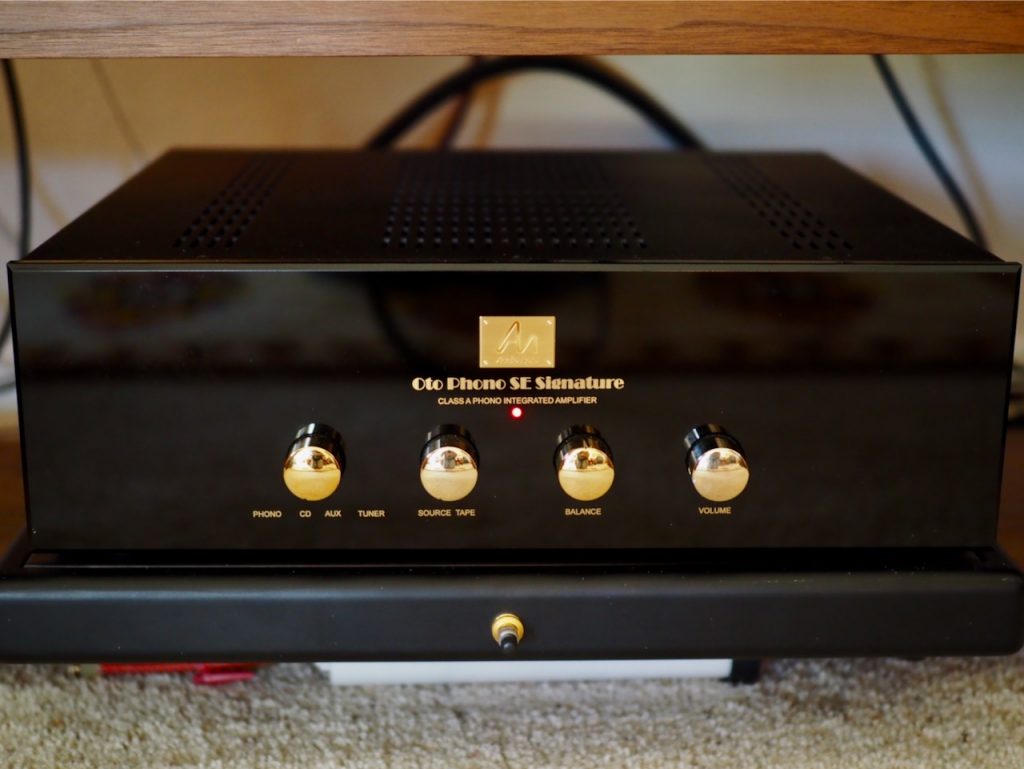
Audio Note (UK) Oto Phono SE Signature integrated amplifier.
On the analog side, the Audio Note (UK) Io I moving coil phonograph cartridge has been providing its musical signal to the Audio Note (UK) AN-S4 step-up transformer (SUT), which is boosting its delicate signal to send via the Audio Note (UK) AN-V silver interconnects to the Audio Note (UK) Oto Phono SE Signature integrated amplifier to power my vintage Altecs.
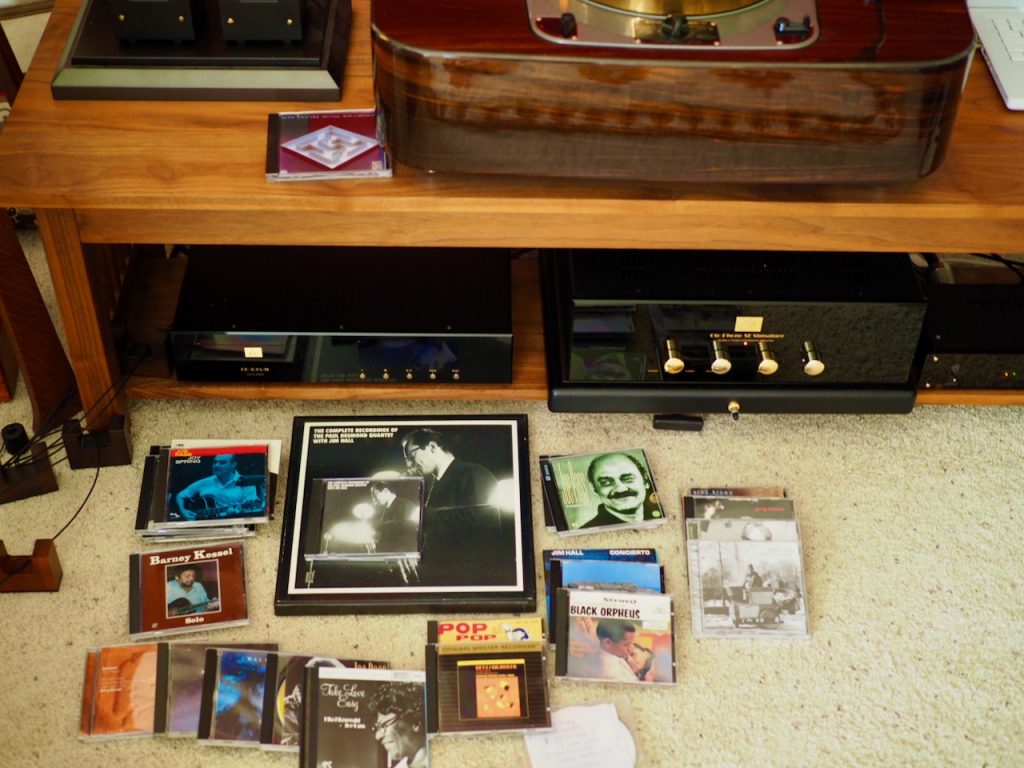
Audio Note (UK) CD 2.1x/II Level Two Red Book CD Player (left), Audio Note (UK) Oto Phono SE Signature integrated amplifier (right).
On the digital front, the source is the always natural sounding and intensely musically engaging Audio Note (UK) CD 2.1x/II Level Two Red Book CD player.
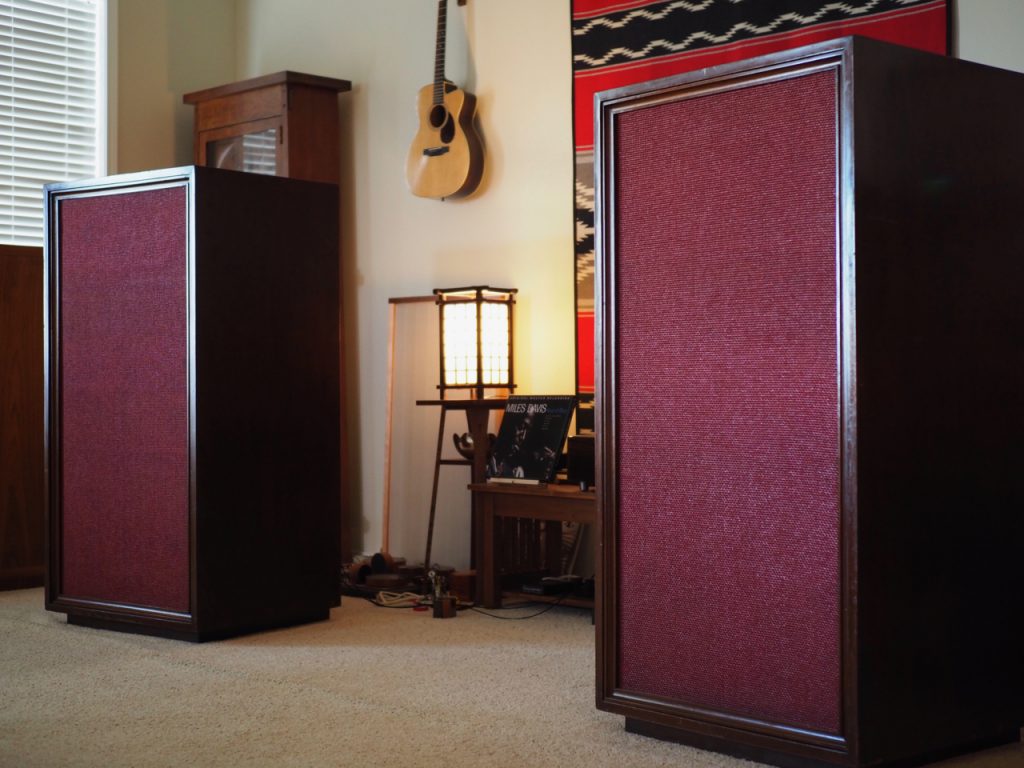
Vintage custom Altec loudspeakers built for conductor Leopold Stokowski.
This combination of Audio Note (UK) kit with my vintage "Stokowski" Altec loudspeakers is absolutely astonishing in its ability to convey the essence of a musical performance.
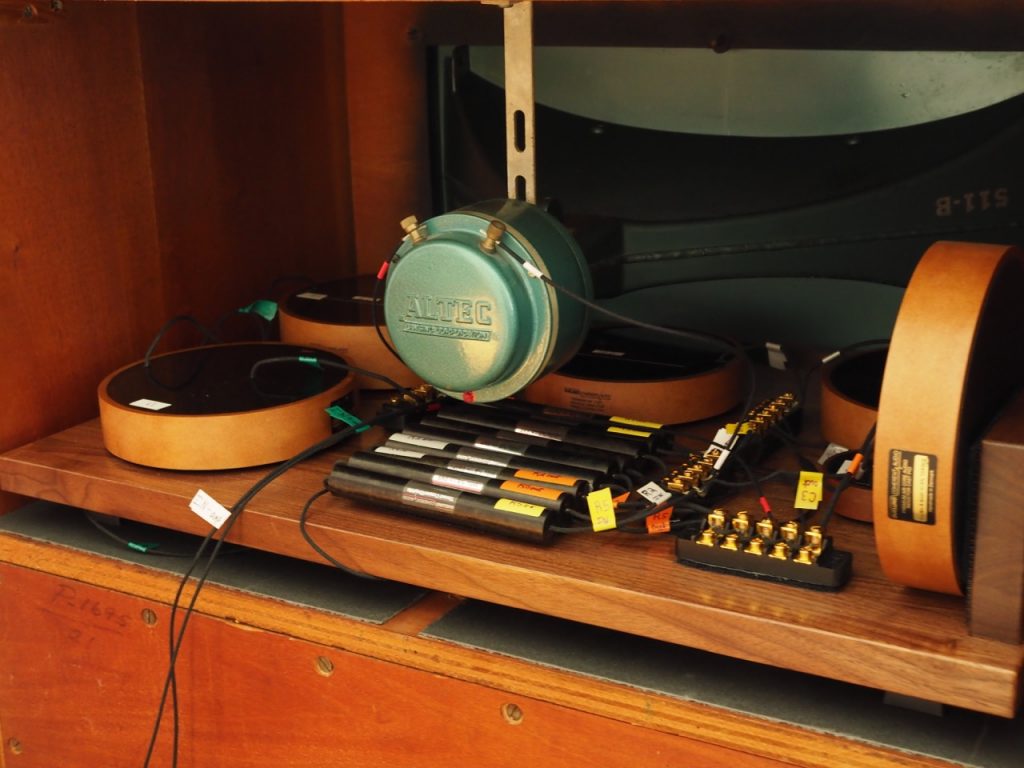
Duelund CAST tinned-copper crossovers in the "Stokowski" Altec loudspeakers.
My vintage Altecs might not be the essence of neutrality with their somewhat rich and sweet "hot fudge sundae" voicing, but that's ok, as these vintage Altec speakers with their Duelund CAST tinned-copper crossovers, in combination with the Audio Note (UK) gear, are so stunning musically that audiophile thoughts of neutrality in loudspeakers seem laughably irrelevant.
I'll be telling you more about this Audio Note (UK) equipment here at Jeff's Place in the coming months as I work towards their Positive Feedback review.
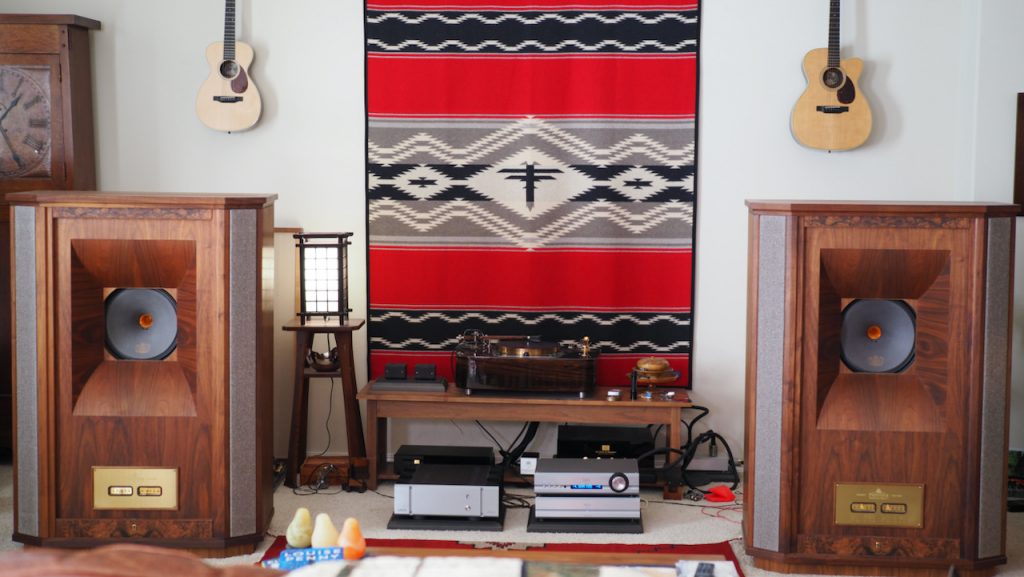
Duelund-Westminster Project loudspeakers with Pass Labs electronics.
On my other listening front are my Tannoy Westminster Royal SE loudspeakers with their Duelund CAST crossovers from the Duelund-Westminster Project of 2013, featuring a mix of pure silver and copper CAST components.
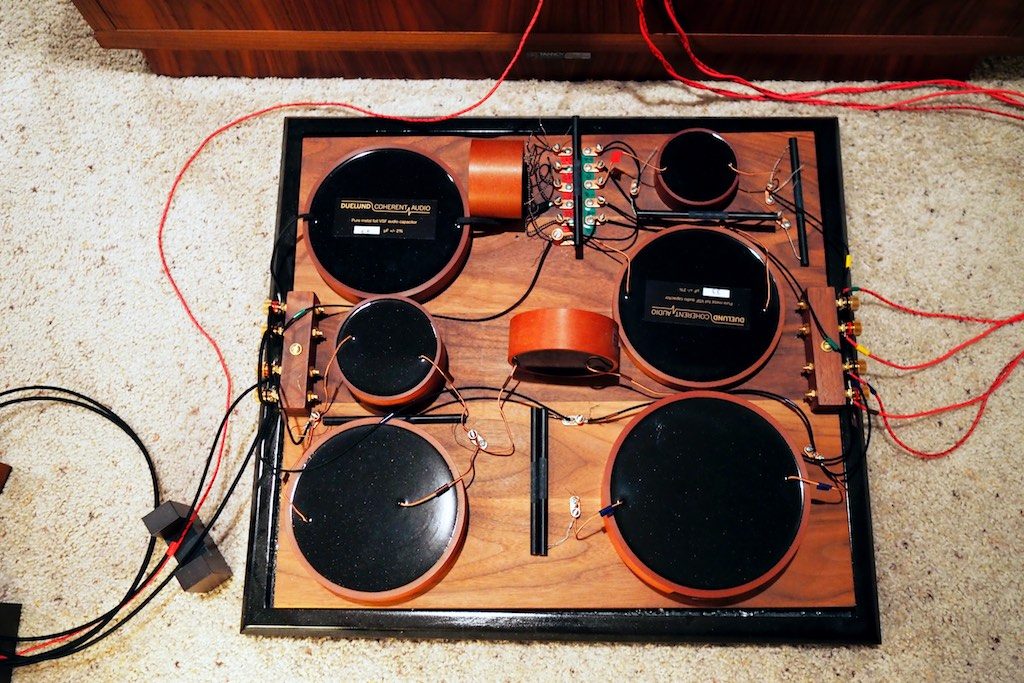
Duelund CAST crossovers for the WRSE's.
I just completed the review for Positive Feedback of the Pass Labs XP-17 phono equalizer (HERE), that I listened to in combination with the Pass Labs XP-12 line preamplifier (HERE) and Pass Labs XA25 (HERE).
I learned a number of things in the Pass Labs XP-17 phono equalizer review, the first being that being able to optimize phono cartridge performance with the XP-17's adjustable gain, resistive loading, and capacitive loading was revelatory in getting the best performance possible out of any given moving-coil, moving-magnet, or moving-iron phonograph cartridge.

Duelund-Westminster Project loudspeakers with Pass Labs XP-17, XP-12, and XA25 electronics.
The second thing I learned was that this combination of entry level Pass Labs separates components provided the best combination of sonic prowess and musicality that I've ever heard from my Westminster loudspeakers, which essentially equalled - and exceeded in some aspects - the performance I was getting with the exotic and phenomenally good ASR Emitter II Exclusive Version Blue amplifier (HERE) and the ASR Basis Exclusive phono equalizer (HERE) combination, for about $26,430 USD less money.

Audio Note (UK) Io I moving coil phonograph cartridge.
The Audio Note (UK) Io I moving coil phonograph cartridge also makes a cameo appearance in the Pass Labs XP-17 phono equalizer review, so you Audio Note (UK) aficionados will want to check that out.
I've also got a special treat for you Pass Labs and First Watt enthusiasts coming up in the very near future as well.
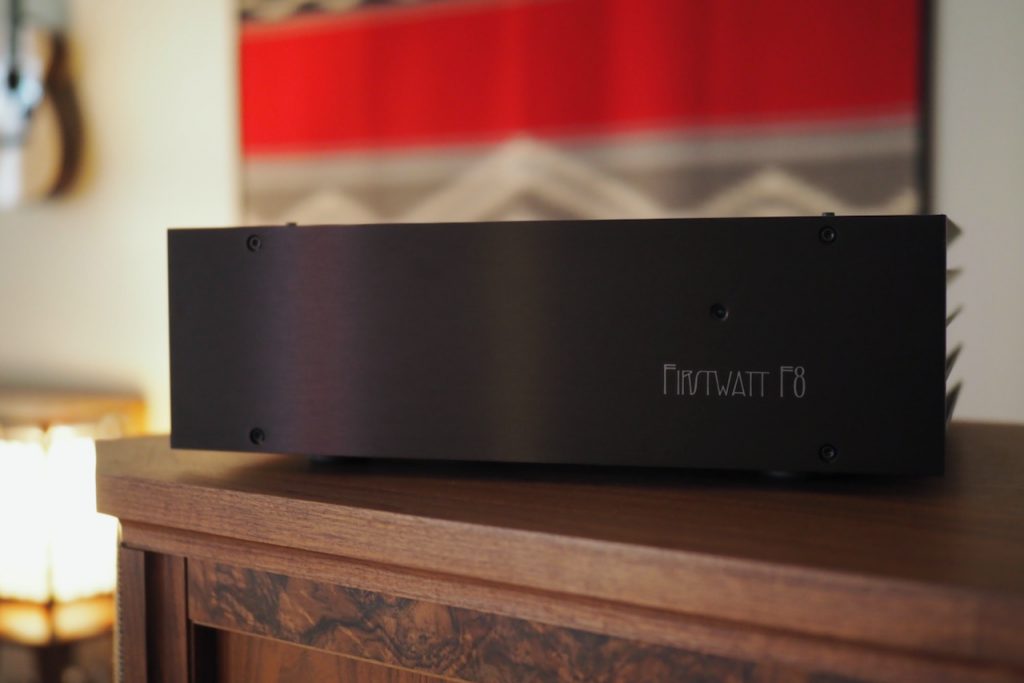
The new First Watt F8 stereo amplifier from Nelson Pass.
As you are probably aware, the much-anticipated new First Watt F8 stereo amplifier by Nelson Pass is here now at Jeff's Place, and in the very near future I'll be telling you about its performance with my Tannoy Westminster Royal SE loudspeakers, along with ...
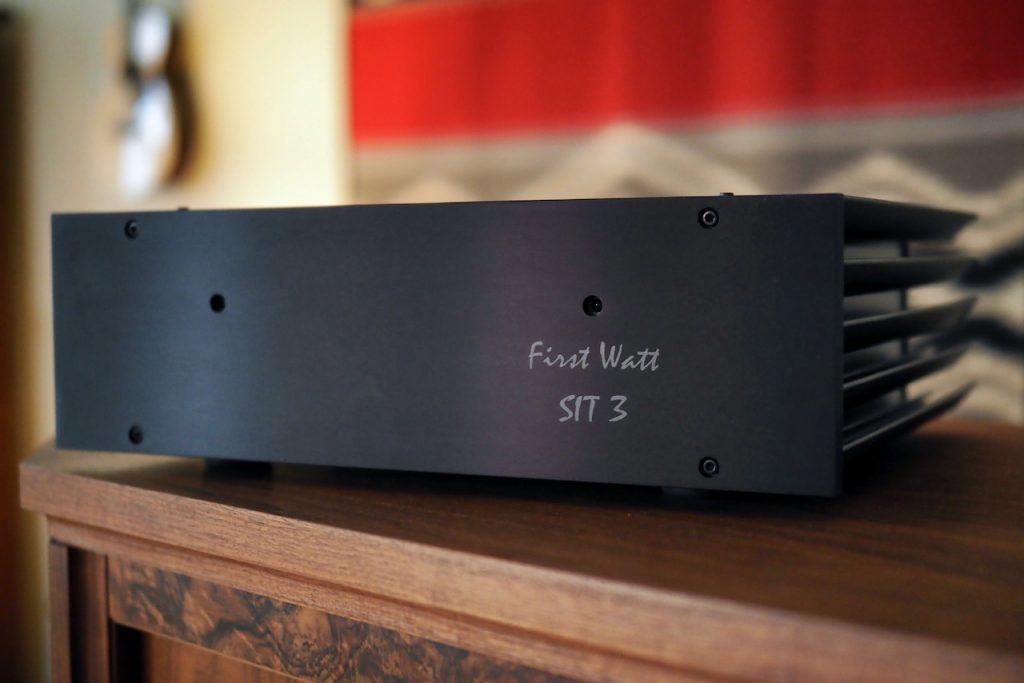
The First Watt SIT-3 stereo amplifier by Nelson Pass.
... revisiting the First Watt SIT-3 stereo amplifier (HERE) by Nelson Pass, in combination with the Pass Labs XP-17 phono pre (HERE) and XP-12 line-level pre (HERE).
After I share with you my impressions of the new First Watt F8 stereo amplifier and the First Watt SIT-3 stereo amplifier powering my Westminsters, with the aid of the Pass Labs XP-17 phono and XP-12 pre, it will be time to tear down the Westminster Royale SE loudspeakers system and reinstall the "Stokowski" Altec loudspeakers in preparation for the next Positive Feedback review in my queue, the gorgeous Triode Lab 45 Evo integrated amplifier from Canada.

Triode Lab 45 EVO SET integrated amplifier.
For a while now, I've been listening to the beautiful Triode Lab 45 EVO SET integrated amplifier with its exotic glowing glass bottles in my vintage Altec A5 Voice of the Theatre audio-visual system, and the combination of SET power with the big Altec A5 theater loudspeakers is the stuff dreams are made of for film viewing or music listening.
I just have to pinch myself at times to make sure I'm not dreaming, as it is such a treat and privilege to have such an array of amazing hifi equipment here at Jeff's Place to tell you about.
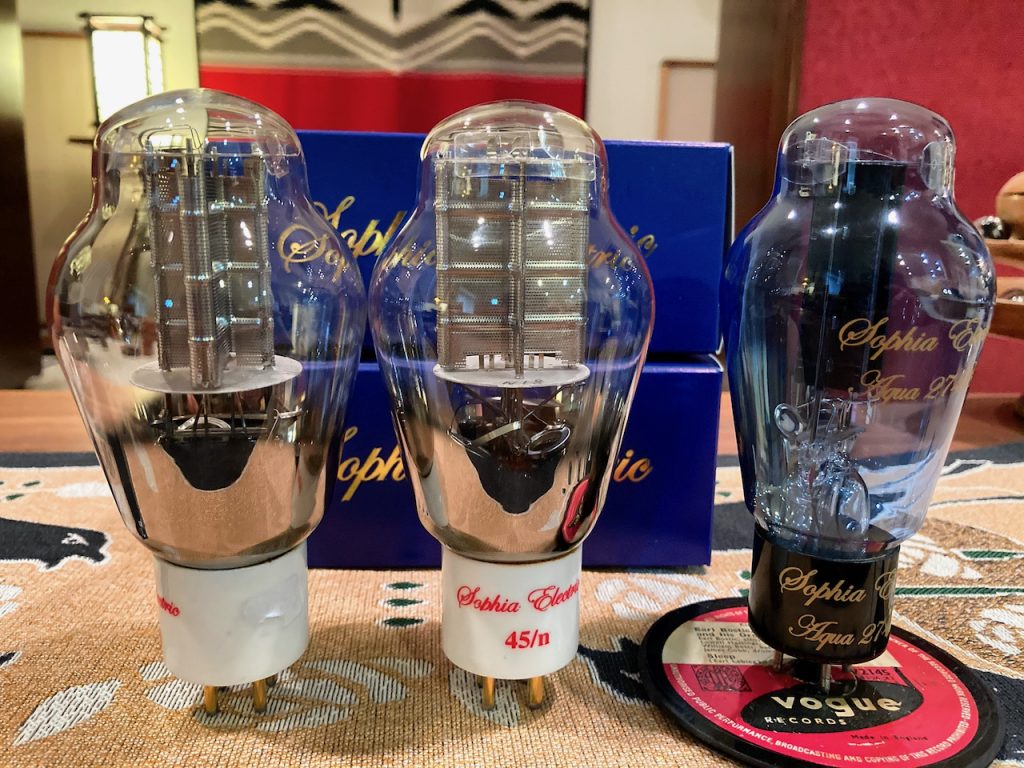
Sophia Electric 45 mesh plate power tubes (left), and Sophia Electric Aqua 274B rectifier (right).
Prior to the Positive Feedback review of the Triode Lab 45 EVO SET, I'll be telling you about the performance of the Sophia Electric 45 mesh plate power tubes (left), and Sophia Electric Aqua 274B rectifier (right), which are now fully run-in and sound superb.
I'll compare the Sophia Electric bottles to the Emission Labs 45 mesh plate power tubes and Psvane Acme 274B rectifier that Frankie at Triode Labs sent along with the 45 EVO as his preferred vacuum tube complement.
It's nice to know there are such superb vacuum tube choices out there that have their own unique tonal qualities so that you can dial in the voicing you want.
I'll also be discussing these two fine vacuum tube choices with you in detail in the Positive Feedback review of the Triode Lab 45 EVO SET, so stay tuned for that.

Manley Laboratories Massive Passive "The Mastering Version".
I also have some very fine news to share with you, EveAnna Manley of Manley Laboratories is going be sending me the Massive Passive "The Mastering Version" pro studio equalizer to try in my enthusiast audio systems here at Jeff's Place, which I am totally excited and delighted to tell you about.
If you've read my review about the Pass Labs XP-17 phono equalizer you know I was blown away by the difference that optimizing the performance of phono cartridges can make for overall system performance and voicing.

Photo of Pultec EQP-1A courtesy of Vintage King Pro Audio.
I was discussing the Pass Labs XP-17 phono equalizer's wonders with audio luminary Bruce Berman, when we got off on the larger topic of equalization of the entire system like they do in studios, something that has been sorely missing from most high-performance enthusiast audio systems for a long time.
Mark Donen commented about how the vintage classic Pultec EQP-1A two band studio valve equalizer was used to provide that magic studio sound quality of a "wide-open sound that instantly adds a warm, airy feeling to recordings" that you hear on the best recordings since it was introduced to the studio world in 1951 by Gene Shenk and Ollie Summerland.
These now legendary vintage Pultec EQP-1A's are coveted in studio circles, rarely turn up for sale, and are now hard to find and quite expensive. Did I mention that you need two of them for stereo? You do, making it even a bit more challenging if you wanted to score a vintage pair of your own.
In a moment of serendipity, Positive Feedback Editor Dr. David Robinson contacted me and said, "Did you know that EveAnna Manley makes new versions of Pultecs in her Manley Laboratories pro audio electronics product line for studios?"

Manley Laboratories Massive Passive "The Mastering Version".
I didn't have a clue about that fact, and David went on to tell me that EveAnna has just come out with a new upgraded stereo Mastering Version, called the Massive Passive "The Mastering Version" (above).
Well, to make a not so long story even shorter, EveAnna is going to send me a Massive Passive "The Mastering Version" - which she thought would be the best choice of an equalizer for enthusiast audio.
Essentially a Massive Passive "The Mastering Version" allows a music listener to dial-in the performance of an audio system perfectly, and match system voicing to get a studio quality level of performance from every album you want to listen to with the turn of a few knobs.
I'll be writing up a history of the use of equalization in studios to achieve that "master tape sound" before too long, as well as mention its contribution to creating the entirety of our recorded music canon over history, and providing you some examples of equalizing enthusiast audio systems here at Jeff's Place to optimize them for program material, just like they do when mastering in the studios.
The implications for performance improvement in enthusiast audio are mind boggling, and here's just a brief view of the powerful abilities a device like the recording studio Massive Passive "The Mastering Version" makes possible.
I was reading through a discussion of recording studio techniques recently, which broke down the audio spectrum into seven frequency bands, and how the perception of the overall sound can be altered by adjusting the equalization for each of those frequency bands.
I thought the discussion provided some nice examples of how changing equalization in the frequency bands affects overall sound quality.
The frequency bands discussed were the sub-bass (20-60Hz), the bass (60-250Hz), the lower midrange (250-500Hz), the midrange (500-2000Hz), the upper midrange (2000-4000Hz), the presence region (4000-6000Hz), and the brilliance region (6000 to 20,000Hz).
I'm just going to mention how a studio equalizer like the Massive Passive "The Mastering Version" can be used to voice a system for program material from the midrange on up, to give you a feel for what can be accomplished with recording studio gear, and I'll fill you in on the midrange on down later.
Boosting the midrange (500-2000Hz) can make some instruments sound more prominent, but can also alter the timbre of the human voice, with too much boost in the midrange making the sound fatiguing to listen to.
Altering the upper midrange (2000-4000Hz) alters the timbre of instruments and vocals. This is also the region where the attack of percussion and rhythm instruments occurs, so boosting it can add presence, but boosting it too much can cause listening fatigue.
The presence region (4000-6000Hz) is responsible for the sense of overall resolution and clarity of the sound. Boosting this region too much can cause the sound to become harsh and irritating, and cutting it too much can cause the sound to become more distant and less resolved.
The brilliance region (6000 to 20,000Hz) is where the harmonics, sparkle, and "air" of the recording resides. Boosting around 12,000Hz gives a "hifi spectacular" sort of presentation, with too much boost accentuating noise and tape hiss which can cause increased listening fatigue.
Essentially, what a device like the Massive Passive "The Mastering Version" makes possible is optimizing your system for your tastes and needs to give a "master tape" like quality to whatever music you choose to listen to.
Whether you are an audiophile who wants to optimize your system for visuospatial performance, or a music lover who wants to optimize your system for musicality, you can do it with a Massive Passive "The Mastering Version" pro equalizer.
You can dial-in the Massive Passive "The Mastering Version" to get the exact tonal balance you desire for your personal tastes. In fact, depending on your mood, you could switch back and forth between both those two listening paradigms to hear how the other side lives with the turn of a few knobs.
Many thanks to EveAnna Manley and Dr. David Robinson for the serendipitous event of making this exciting Massive Passive "The Mastering Version" studio pro equalizer available to write about for the readers of Jeff's Place and Positive Feedback.
Ok, that's it for now. As always, thanks for stopping by, and may the tone be with you!



























